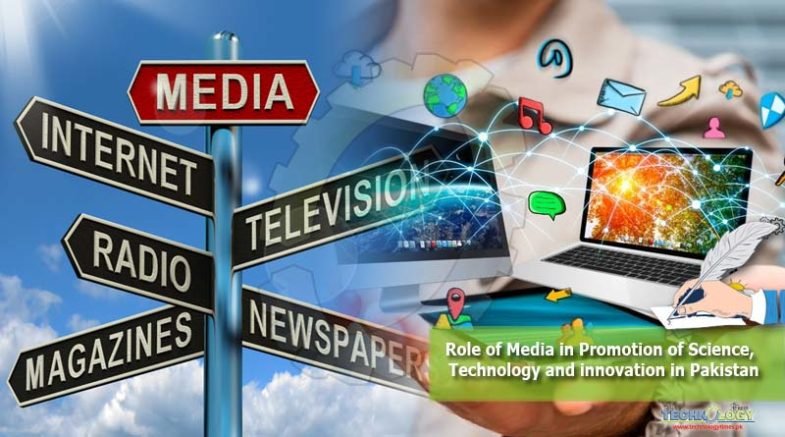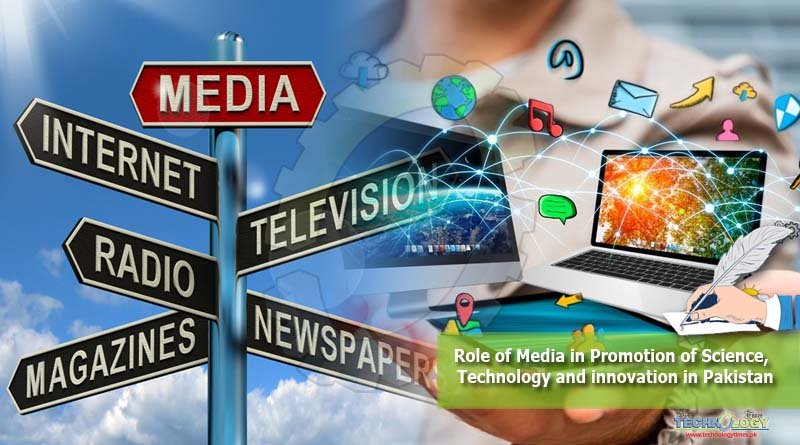The role of media in the promotion of science and technology is very important.
 The science and technology culture is very much important for the socioeconomic growth of the country and needs to be contributed by every stakeholder. The media is now the fourth pillar of society and influence people to opinion significantly.
The science and technology culture is very much important for the socioeconomic growth of the country and needs to be contributed by every stakeholder. The media is now the fourth pillar of society and influence people to opinion significantly.
The global media like CNN, BBC, CNBC, CGTN, and others give reasonable coverage ranging from 15% to 25% of their covered contents to science and technology developments and updates. We propose that Pakistani media and media communities need to volunteer and make S&T part of their coverage. Pakistani media needs to highlight the state of S&T in Pakistan, its significant, global comparisons and how S&T should be prioritized to contribute to the development. The economic growth targets are very much dependent on the level of technology in the country.
We propose that “A Science Hour” to be scheduled by all TV channels and the same to be appreciated by PEMRA, the national parliament, the senate of Pakistan and concern miniseries. The role of media is very critical in educating the public on the importance of science and technology in society. The media can help in building “Innovative Pakistan”
The Important Role of Media
The media have the power to create an intellectual environment in any society. Media can create academic and logical temperament in the populace, or adversely, non-serious environment, confusion, uncertainty, disappointment and frustration by bringing sensationalism, propaganda and political slogans in its content. The media can assess our own position, can point out our deficiencies and lead the nation towards the destination of progress and prosperity through the path of science and technology.
The role of the media is crucial and ranges from promoting national identity and cohesion to galvanizing the resolve of peoples in achieving progress and development as well as meeting contemporary challenges. The twenty-first century poses new challenges and opportunities in which the role of the media will be of fundamental importance. The factors that will impact upon national development in the 21st century include geopolitical, economic, technological, social and cultural conditions of intense, rapid change as well as resistance to change.
The media become comforting life-lines of affinity-connectivity. The media provides information to actors throughout society allowing them to participate in the decisions and debates that shape their lives. The media also play an important monitoring role in a democracy that enables citizens to hold their governments and elected officials accountable leading to better policies and service implementation.
Keeping the national goals and accomplishments always before the public through modern communication can help weld together isolated scientific communities into truly national development. Despite a general agreement on the importance of media development in broader social, economic and political and technological progress, the international communities, governments, development agencies, donors largely view the development of an independent media sector as a matter of critical importance.
The Impact Areas of Media Advocacy
Governance: Media improves governance by monitoring and participating in the actions of the Govt, access to information. A plural media improves government responsiveness by giving a voice to the relevant stakeholders.
Economic Impact: Media improves the efficiency of the economy by providing actors more and better information with which to make decisions and improving stability. One of the fundamental factors of economic stability relies on Science & Technology progress and its foot-prints in the society.
Social Impact: Media catalyzes positive changes in society by providing information that influences public opinion. Media leads to increases in awareness and changes in behavior across society through the application of science & technology to address social issues.
Innovation: The role of media for improving innovation factor in competitiveness and economic development has become increasingly important
The S & T Advocacy through Media
Science and technology are closely associated with our lives. They have closely linked aspects of society and the studies and developments in both these fields are essential for the overall progress of mankind. Scientific research comprises a wide variety of fields ranging from the study of different branches of science to relatively advanced fields. It is important for the progress of mankind particularly for a country like Pakistan which is lagging in terms of technology, innovation, and scientific accomplishments. The seemingly impossible feats have been made possible, thanks to scientific research.
Natural sciences deal with the study of nature and human life. The studies of natural and artificial sciences reveal the relationship between nature and human life. Research in science has paved a path to many brilliant inventions and discoveries. The importance of technology lies in its manifold benefits to society. The positive effects of technology are many. The advancement in this field has revolutionized human life. It has provided an impetus to the computer and the telecommunication industry.
The physical frontiers and the communication frontiers and advancement of Science & Technology of nation-states are likely to be in sharp contrast even as they sometimes converge. The electronic linkages may assume new shared roles including;
- As articulators of national identity, promoting campaigns for the various disciplines of Science & Technology through scholarly debate, discussion, and analysis as re-enforcers of recognized national priorities.
- As stokers of national pride and cohesion in science & technology through representatives of diverse stakeholders and creating motivation and spirit for the enhancement of S & T.
- Sources for valuable information about S& T development, as in providing guidance and advice to various sectors of the economy like; agriculture, water, climate change, industry, energy, I.T, education, health, etc. to promote the concept of development communications.
- Unabashed, unapologetic instruments of state propaganda and governmental S & T policies.
- Means of expression for the marginalized scientists, researchers, students, experts, scholars to share their valuable input for the S & T development.
S&T Advocacy and Coverage in International Media
Here is a mention of some channels that are dedicated to S&T. These channels are 100% percent focus on promoting science and technology through highlighting scientific and technological advances, the process of scientific inquiry, and connecting science with general communities. The drive for launching such channels began globally in the 1980s. The world realized the importance long ago, we need to realize now: it’s better late than never.
S&T Focused Channels
- Knowledge Network (Canada Based) Launched in 1981,
- Discovery (USA based) Launched in 1985,
- France 5 (France based) launched in 1994,
- History (USA based) Launched in 1995,
- Canal D (Canada based) Launched in 1995,
- Animal Planet (USA based) Launched in 1996,
- Science (USA based) Launched in 1996,
- Space (Canada based) Launched in 1997,
- National Geographic (USA based) Launched in 2001,
- Da Vinci Learning (German-based) Launched in 2007,
- Encuentro (Argentina based) Launched in 2007,
- Rai Scuola (Italy based) Launched in 2009,
- Nat Geo Wild (Hong Kong-based) Launched in 2010
S&T Coverage by International Channels
Following is a list of top channels of different countries, along with the example of a program related to S&T and allied filed. Tentatively estimated percentages are provided as well.
All the above-given examples are to bring clarity in comprehending the importance of science communication that the developed world has recognized long ago. Developing countries like ours are in emergent need of conscious effort to promote science and technology through mass media communication. This is the only solution to move forward and meet the pace of the world that is changing with high velocity.
Increasing Global Focus on S&T Communication
Case of EU: In the European Union, public views on public-funded research and the role of governmental institutions in funding scientific activities were being questioned as the budget allocated was increasing. Therefore, the European Commission encouraged strongly and later obligated research organizations to communicate about their research activities and results widely and to the general public. This is being done by integrating a communication plan into their research project that increases the public visibility of the project using accessible language and adapted channels and materials.
COPUS: Committee on the Public Understanding of Science (COPUS), the collaboration between the British Association for the Advancement of Science, the Royal Society and the Royal Institution, focused on science movement to be taken seriously. Now COPUS has been adopted in the US by the Coalition on the Public Understanding of Science, an organization that is funded by the US National Academy of Sciences and the National Science Foundation and focuses on popular science projects such as science cafes, festivals, magazines, and citizen science schemes.
UNESCO-TWAS: The principal aim of The World Academy of Science (TWAS) is to promote scientific capacity and excellence for sustainable development in developing countries. It was formerly known as the Third World Academy of Sciences. Developing countries account for 80% of the world’s population, only 28% of the world’s scientists hail from these countries. This fact reflects the lack of innovative potential necessary to solve real-life problems affecting poor nations. Therefore founding members of TWAS decided to “Recognize, support and promote science, provide facilities to promising science efforts, promote scientific research and connect industry
AAAS: American Association for the Advancement of Science (AAAS) is an American international non-profit organization with the stated goals of promoting cooperation among scientists, defending scientific freedom, encouraging scientific responsibility, supporting scientific education and science outreach for the betterment of all humanity.
Conclusion and Way Far ward
There are tools in the hands of media through which they can promote an environment suitable for the advancement of science and technology which includes; TV, radio, print, online and social media, and documentaries as well as advocacy through seminars/summits /conferences in close liaison with the industry. Allocation of dedicated prime-time in the TV channels for S& T which may be considered as a national obligation as well to meet one mandatory role of the media to be the part of national development. There is an urgent need to engage other media advocacy, policy political and social organizations to advance science-media communication and interaction.
The public-funded S&T projects must have communication funds and promote through social, digital and print media. There is a need to conduct regular training programs for media persons to cover S&T news and play a positive role in this regard. There is a need to have S&T communication units in the ministry of S&T, degree programs in science journalism, and course of science journalism in life sciences education programs.
Authors:
- Rahmat Ullah, Executive Director, Institue of Research Promotion, General Secretary, South Asia Triple Helix Association- SATHA and Director ORIC, USKT.
- Dr. Rashid Aftab, Director, Ripha Institue of Public Policy
- Dr. Ali Hamza, Assistant Professor, Faculty of Business and Management,
